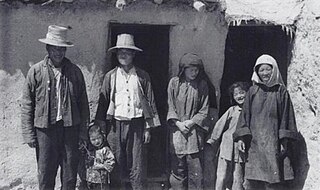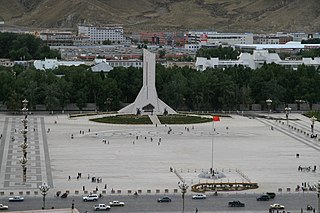| Founded | August 2016 |
|---|---|
| Headquarters | |
| URL | www |
Yongzin (Tibetan : ཡོངས་འཛིན, Chinese :云藏) is the first search engine of Tibetan language in the world. It went live in August 2016, at a cost of 23 million yuan ($3.6 million) [1] from a location in Gonghe County, Hainan Tibetan Autonomous Prefecture, Qinghai Province, China. [2] [3]
"Yongzin" is a Tibetan word. The first meaning is 'teacher'. The second meaning (by dividing the word into two characters) is 'to acquire comprehensively'. [3]
Yongzin is developed by the Tibetan Language Information Technology Research Center of Hainan Tibetan Autonomous Prefecture. This project is started from April 2013, and it belongs to the 'Tibetan language informationization construction' project, which is a part of the 12th five-year plan for the ethnic minorities of Qinghai Province. [2] [3]
According to a testing in 2016, the search engine censored some Tibetan words, including "Free Tibet", "Dalai Lama" and even "Tibetan tea". [4]
Yongzin has eight parts: news, webpage, image, video, audio, encyclopedia, library, and know. Yongzin intends to build the biggest Tibetan digital library in the world, and develop software for Tibetan-language users. [2]
In August 2020, Yongzin released a upgraded search engine app, which adopted an AI-based Tibetan word segmentation system. Yongzin also released an input method software supporting Tibetan, Chinese and English. [5]

Tibet, or Greater Tibet, is a region in the central part of East Asia, covering much of the Tibetan Plateau and spanning about 2,500,000 km2 (970,000 sq mi). It is the homeland of the Tibetan people. Also resident on the plateau are some other ethnic groups such as the Monpa, Tamang, Qiang, Sherpa and Lhoba peoples and, since the 20th century, considerable numbers of Han Chinese and Hui settlers. Since the annexation of Tibet by the People's Republic of China in 1951, the entire plateau has been under the administration of the People's Republic of China. Tibet is divided administratively into the Tibet Autonomous Region, and parts of the Qinghai and Sichuan provinces. Tibet is also constitutionally claimed by the Republic of China as the Tibet Area since 1912. Tibet is the highest region on Earth, with an average elevation of 4,380 m (14,000 ft). Located in the Himalayas, the highest elevation in Tibet is Mount Everest, Earth's highest mountain, rising 8,848.86 m (29,032 ft) above sea level.

Amdo is one of the three traditional Tibetan regions, the others being U-Tsang in the west and Kham in the east. Ngari in the north-west was incorporated into Ü-Tsang. Amdo is also the birthplace of the 14th Dalai Lama. Amdo encompasses a large area from the Machu to the Drichu (Yangtze). Amdo is mostly coterminous with China's present-day Qinghai province, but also includes small portions of Sichuan and Gansu provinces.

Tibetan Muslims, also known as the Khache, are Tibetans who adhere to Islam. Many are descendants of Kashmiris, Ladakhis, and Nepalis who arrived in Tibet in the 14th to 17th centuries. There are approximately 5,000 Tibetan Muslims living in China, over 1,500 in India, and 300 to 400 in Nepal.

Shigatse, officially known as Xigazê, or Rikaze, is a prefecture-level city of the Tibet Autonomous Region of the People's Republic of China. Its area of jurisdiction, with an area of 182,000 km2 (70,271 sq mi), corresponds to the historical Ü-Tsang region of Tibet.

Garzê Tibetan Autonomous Prefecture, often shortened to Ganzi Prefecture, is an autonomous prefecture in the western arm of Sichuan province, China bordering Yunnan to the south, the Tibet Autonomous Region to the west, and Gansu to the north and northwest.

Haixi Mongolian and Tibetan Autonomous Prefecture, locally also known as Qaidam Prefecture, is an autonomous prefecture occupying much of the northern half of Qinghai Province, China. It has an area of 325,785 square kilometres (125,786 sq mi) and its seat is Delingha. The name of the prefecture literally means "west of (Qinghai) Lake."

Yushu Tibetan Autonomous Prefecture, also transliterated as Yüxü or Yulshul, is an autonomous prefecture of Southwestern Qinghai Province, China. Largely inhabited by Tibetans, the prefecture has an area of 188,794 square kilometres (72,894 sq mi) and its seat is located in the town of Gyêgu in Yushu County, which is the place of the old Tibetan trade mart of Jyekundo. The official source of the Yellow River lies within the prefecture. Historically, the area belongs to the cultural realm of Kham in Eastern Tibet.

Hainan Tibetan Autonomous Prefecture, formerly known as Tsolho Tibetan Autonomous Prefecture, is an autonomous prefecture of Northeastern Qinghai Province in Western China. The prefecture has an area of 45,895 square kilometres (17,720 sq mi) and its seat is located in Gonghe County. Its name literally means "south of (Qinghai) Lake."

Litang is in southwest of Garzê Tibetan Autonomous Prefecture, Sichuan, China.

The history of Tibet from 1950 to the present includes the Chinese invasion of Tibet in 1950, and the Battle of Chamdo. Before then, Tibet had been a de facto independent nation. In 1951, Tibetan representatives in Beijing signed the Seventeen Point Agreement under duress, which affirmed China's sovereignty over Tibet while it simultaneously supported the establishment of an autonomous administration which would be led by Tibet's spiritual leader, and then-political leader, the 14th Dalai Lama. During the 1959 Tibetan uprising, when Tibetans attempted to prevent his possible assassination, the Dalai Lama escaped from Tibet and moved to northern India, where he established the Central Tibetan Administration, which rescinded the Seventeen Point Agreement. The majority of Tibet's land mass, including all of U-Tsang and areas of Kham and Amdo, was officially established as the Tibet Autonomous Region, within China, in 1965.

Taktser or Tengtser or Hongya Village is a village in Shihuiyao Township, Ping'an District, Haidong, in the east of Qinghai province, China. Tibetan, Han and Hui Chinese people populate the village which is notable as the birthplace of the 14th Dalai Lama, Tenzin Gyatso.

The following outline is provided as an overview of and topical guide to Tibet:

The sinicization of Tibet includes the programs and laws of the Chinese government and the Chinese Communist Party (CCP) to force cultural assimilation in Tibetan areas of China, including the Tibet Autonomous Region and the surrounding Tibetan-designated autonomous areas. The efforts are undertaken by China in order to remake Tibetan culture into mainstream Chinese culture.

Tibet was a country in East Asia that lasted from the collapse of the Manchu-led Qing dynasty in 1912 until its annexation by the People's Republic of China in 1951.

Xinghai County is a county under the jurisdiction of Hainan Tibetan Autonomous Prefecture, in the east-central part of Qinghai Province, China.

Guide County is a county in the east of Qinghai Province, China. It is under the administration of Hainan Tibetan Autonomous Prefecture. In Tibetan it is known as Trika. In 2015 it had a population of 108,800, of which 37.8% Tibetans, and 16.1% other ethnic minorities. In 2018 the population was 110,900.

Guinan County is a county in the east of Qinghai Province, China. It is under the administration of Hainan Tibetan Autonomous Prefecture. The seat of Guinan County is in the Town of Mangqu.
Chen Qingying, is a Chinese Tibetologist. He is the director of the History Research Institute under the China Tibetology Research Center.
The 29-Article Ordinance for the More Effective Governing of Tibet was supposed to be an imperial decree published in 1793 by the Qianlong Emperor in the Qing dynasty, the last imperial dynasty of China. Article 1 states that the purpose of Golden Urn is to ensure prosperity of Gelug, and to eliminate cheating and corruption in the selection process. Article 12 states that relatives of the Dalai Lama or Panchen Lama must not hold government positions, or participate in political affairs.

The G0613 Xining–Lijiang Expressway, also referred to as the Xili Expressway, is an under construction expressway in China that connects Xining, Qinghai to Lijiang, Yunnan.